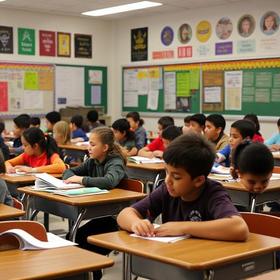Serving 418 students in grades 9-12, Urban Assembly Gateway School For Technology ranks in the bottom 50% of all schools in New York for overall test scores (math proficiency is bottom 50%, and reading proficiency is bottom 50%).
The percentage of students achieving proficiency in math is 25-29% (which is lower than the New York state average of 52%). The percentage of students achieving proficiency in reading/language arts is 40-49% (which is approximately equal to the New York state average of 49%).
The student-teacher ratio of 13:1 is higher than the New York state level of 11:1.
Minority enrollment is 88% of the student body (majority Hispanic), which is higher than the New York state average of 60% (majority Hispanic).
Quick Facts (2025-26)
- School Type: Vocational school
- Grades: 9-12
- Enrollment: 418 students
- Student-Teacher Ratio: 13:1
- Minority Enrollment: 88%
- Graduation Rate: ≥95% (Top 10% in NY)
- Overall Testing Rank: Bottom 50%
- Math Proficiency: 25-29% (Btm 50%)
- Reading Proficiency: 40-49% (Btm 50%)
- Science Proficiency: ≥95% (Top 5%)
- Source: National Center for Education Statistics (NCES), NY Dept. of Education
Top Rankings
Urban Assembly Gateway School For Technology ranks among the top 20% of public schools in New York for:
Category
Attribute
Science Proficiency
Graduation Rate
School Overview
Urban Assembly Gateway School For Technology's student population of 418 students has declined by 8% over five school years.
The teacher population of 33 teachers has grown by 6% over five school years.
School Type
Grades Offered
Grades 9-12
(Supplemental Virtual)
(Supplemental Virtual)
Total Students
418 students
Gender %
Total Classroom Teachers
33 teachers
School Calendar
School Rankings
Urban Assembly Gateway School For Technology ranks within the bottom 50% of all 4,346 schools in New York (based off of combined math and reading proficiency testing data).
The diversity score of Urban Assembly Gateway School For Technology is 0.60, which is less than the diversity score at state average of 0.72. The school's diversity has stayed relatively flat over five school years.
Overall Testing Rank
#3201 out of 4346 schools
(Bottom 50%)
(Bottom 50%)
Math Test Scores (% Proficient)
25-29%
52%
Reading/Language Arts Test Scores (% Proficient)
40-49%
49%
Science Test Scores (% Proficient)
≥95%
78%
Student-Teacher Ratio
13:1
11:1
American Indian
2%
1%
Asian
6%
10%
Hispanic
59%
30%
Black
20%
16%
White
12%
40%
Hawaiian
n/a
n/a
Two or more races
1%
3%
All Ethnic Groups
Graduation Rate
≥95%
87%
Participates in the National School Lunch Program (NSLP)
Yes
Eligible for Free Lunch
69%
54%
Eligible for Reduced Lunch
3%
3%
School Statewide Testing
School District Name
Source: National Center for Education Statistics (NCES), NY Dept. of Education
Profile last updated: 02/09/2025
Frequently Asked Questions
What is Urban Assembly Gateway School For Technology's ranking?
Urban Assembly Gateway School For Technology is ranked #3201 out of 4,346 schools, which ranks it among the bottom 50% of public schools in New York.
What percent of students have achieved state testing proficiency in math and reading?
25-29% of students have achieved math proficiency (compared to the 52% NY state average), while 40-49% of students have achieved reading proficiency (compared to the 49% NY state average).
What is the graduation rate of Urban Assembly Gateway School For Technology?
The graduation rate of Urban Assembly Gateway School For Technology is 95%, which is higher than the New York state average of 87%.
How many students attend Urban Assembly Gateway School For Technology?
418 students attend Urban Assembly Gateway School For Technology.
What is the racial composition of the student body?
59% of Urban Assembly Gateway School For Technology students are Hispanic, 20% of students are Black, 12% of students are White, 6% of students are Asian, 2% of students are American Indian, and 1% of students are Two or more races.
What is the student-teacher ratio of Urban Assembly Gateway School For Technology?
Urban Assembly Gateway School For Technology has a student ration of 13:1, which is higher than the New York state average of 11:1.
What grades does Urban Assembly Gateway School For Technology offer ?
Urban Assembly Gateway School For Technology offers enrollment in grades 9-12 (Supplemental Virtual).
What school district is Urban Assembly Gateway School For Technology part of?
Urban Assembly Gateway School For Technology is part of New York City Geographic District # 2.
School Reviews
5 10/10/2025
UAG has been a great choice for my son. The teachers are very involved; they push the students to succeed and offer them extra help during GOLD. The school feels warm and welcoming. The principal is very caring and treats each student like her own.
Review Urban Assembly Gateway School For Technology. Reviews should be a few sentences in length. Please include any comments on:
- Quality of academic programs, teachers, and facilities
- Availability of music, art, sports and other extracurricular activities
Recent Articles

How Public Schools Support Students on Free / Reduced-Lunch Programs
Explore how U.S. public schools support students eligible for free or reduced-price lunch through nutrition, academic, and wraparound services in 2025.

Hidden Costs of Public Schools: Fees, Supplies & Extras
Explore the hidden costs in public schools—fees, supplies, extracurriculars—and how parents can plan for them in 2025.

Public School Funding 2025: What Families Should Know
Essential insights on public school funding in 2025—how it works, what’s changing, and what families should know to stay ahead.









